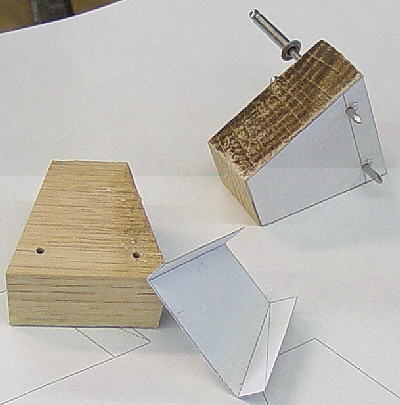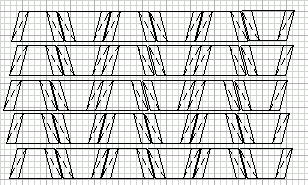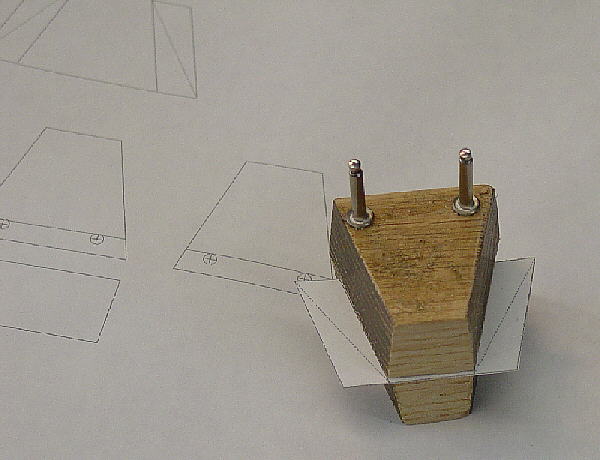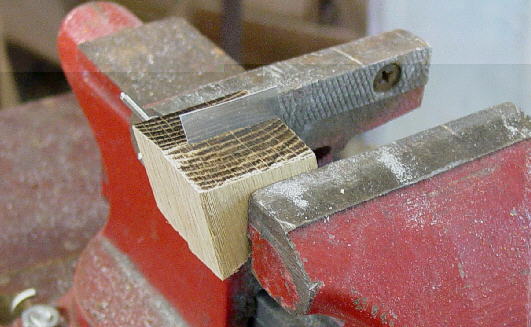|
|
|
Making Blank VGs
|
|
|
|
A bending fixture was made from a 3/4 inch by 1-1/4 inch oak strip. Two pieces were cut to fit the inside of the bends. Using a radial arm saw, the arm was rotated horizontally to 15 degrees and the plane of the blade rotated to cut the sides at a 85 degree angle. This lets one over bend the aluminum so that it springs back to a desired 90 degree bend. Another degree or two might be better, because the rebound seems to be a little more than five degrees. To keep the two clamping/bending pieces in alignment, two 1/16 ID holes were drilled at the through the two blocks on the 1-1/4 inch line. Two pop rivet shanks were used as alignment pins. The blocks are assembled, and the blank part is slipped into place so that it hit the alignment pins and the fold pattern was symmetrical with the blocks. |
|
|
 Another piece of oak strip was used as a bending brake. One slides the block to the up right aluminum and then presses away and over to fold the VG side in one crisp motion.
Another piece of oak strip was used as a bending brake. One slides the block to the up right aluminum and then presses away and over to fold the VG side in one crisp motion.
The vice was loosened and the bending fixture removed, flipped side to side and replaced in the vice so the second fold could be made. |
 The bending fixture was removed from the vice and the blocks separated to remove the formed part. This process was repeated until all blanks were formed.
The bending fixture was removed from the vice and the blocks separated to remove the formed part. This process was repeated until all blanks were formed.
The dark surfaces are not significant and were caused by use of a dull cabinet makers blade. After all VG's were formed the edges were trimmed. |
 After the edges had been trimmed, it was time to remove the pattern that was glued to the aluminum. To loosen the adhesive, the paper pattern was sprayed with WD40 and the pattern removed. Some adhesive remained on the aluminum surface and WD40 and paper towels were used again to remove it.
After the edges had been trimmed, it was time to remove the pattern that was glued to the aluminum. To loosen the adhesive, the paper pattern was sprayed with WD40 and the pattern removed. Some adhesive remained on the aluminum surface and WD40 and paper towels were used again to remove it.
A better technique might be to just soak the whole works in kerosene, and to then clean the VG's with soap and water or to run them through a dish washer. |
 The layout on the previous page was duplicated and rotated so that strings of patterns could be printed out on 8.5 by 14 inch paper. These were cut into strips and the back side was coated with spray adhesive. Aluminum house flashing was cut into strips a little greater than 1.25 inches wide. The paper strips were affixed to the aluminum and the blanks were cut to shape.
The layout on the previous page was duplicated and rotated so that strings of patterns could be printed out on 8.5 by 14 inch paper. These were cut into strips and the back side was coated with spray adhesive. Aluminum house flashing was cut into strips a little greater than 1.25 inches wide. The paper strips were affixed to the aluminum and the blanks were cut to shape.

 The blank was centered in the bending fixture as shown above. The whole assembly was placed in a vice to clamp the blocks against the aluminum blank.
The blank was centered in the bending fixture as shown above. The whole assembly was placed in a vice to clamp the blocks against the aluminum blank.